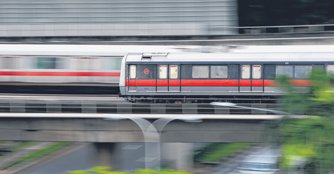12 new MRT trains to be put into service on North-South and East-West lines
13 Aug 2018|1,962 views
In his maiden press event Monday (13th August), Mr. Neo said the 12 new trains "will add capacity and meet commuter demand on the North-South and East-West lines" - the oldest, longest and most heavily-used rail lines here. Currently, the lines have a fleet of 186 trains.
The new trains come with new features, such as enhanced air-con setting to cope with peak passenger load, tip-up seats, which will free up space for around 100 standing passengers during peak hours, and several reliability enhancements.
For instance, an automatic alert will go off when a train's current collector device - which is the part, which makes contact with and draws power from the third rail - is dislodged.
This will prevent major breakdowns such as the twin incidents in December 2011, which led to passengers stranded in tunnels. Mr. Neo revealed that he had "moved to near Shunfu, just to make sure I can take the train to work". He added that he also sold his car "earlier on, but I didn't want to buy a new car because it's more useful for me to take the MRT to understand the issues" of commuters.
The new Chief, who took over from Mr. Desmond Kuek on 1st August, said he had has set out three 'mission objectives' - to deliver reliability, sustainability and continuous improvement. "Reliability is a basic requirement, so we have to do that," he said. "But reliability alone is not enough, you have to sustain it at a level."
He added, "Continuous improvement is a culture we want. This is a trains company, and we will deliver," he said. Asked when the new signalling system will deliver its shorter 100-second service interval - down from 120 seconds now - Mr. Neo said, "Because it is a big system, whatever new project, we do it very systematically, very deliberately.
"There is a project ongoing to look at the headway between the vehicles. Headway is the one that allows us to shorten waiting time. But for now, it's an ongoing project, and at an appropriate time,we will let you know."
Commuter Lionel Tan is among those looking forward to that. The 28-year old accountant who usually takes the East-West line said, "The trains seldom break down now, and that is a good thing. But they are still very crowded, especially during peak hours. There is no difference in that area. We still have to wait for a few trains to pass before we can board one." He said he hopes the shorter headways can be put into effect as soon as possible.
In his maiden press event Monday (13th August), Mr. Neo said the 12 new trains "will add capacity and meet commuter demand on the North-South and East-West lines" - the oldest, longest and most heavily-used rail lines here. Currently, the lines have a fleet of 186 trains.
The new trains come with new features, such as enhanced air-con setting to cope with peak passenger load, tip-up seats, which will free up space for around 100 standing passengers during peak hours, and several reliability enhancements.
For instance, an automatic alert will go off when a train's current collector device - which is the part, which makes contact with and draws power from the third rail - is dislodged.
This will prevent major breakdowns such as the twin incidents in December 2011, which led to passengers stranded in tunnels. Mr. Neo revealed that he had "moved to near Shunfu, just to make sure I can take the train to work". He added that he also sold his car "earlier on, but I didn't want to buy a new car because it's more useful for me to take the MRT to understand the issues" of commuters.
The new Chief, who took over from Mr. Desmond Kuek on 1st August, said he had has set out three 'mission objectives' - to deliver reliability, sustainability and continuous improvement. "Reliability is a basic requirement, so we have to do that," he said. "But reliability alone is not enough, you have to sustain it at a level."
He added, "Continuous improvement is a culture we want. This is a trains company, and we will deliver," he said. Asked when the new signalling system will deliver its shorter 100-second service interval - down from 120 seconds now - Mr. Neo said, "Because it is a big system, whatever new project, we do it very systematically, very deliberately.
"There is a project ongoing to look at the headway between the vehicles. Headway is the one that allows us to shorten waiting time. But for now, it's an ongoing project, and at an appropriate time,we will let you know."
Commuter Lionel Tan is among those looking forward to that. The 28-year old accountant who usually takes the East-West line said, "The trains seldom break down now, and that is a good thing. But they are still very crowded, especially during peak hours. There is no difference in that area. We still have to wait for a few trains to pass before we can board one." He said he hopes the shorter headways can be put into effect as soon as possible.
Latest COE Prices
August 2025 | 2nd BIDDING
NEXT TENDER: 03 Sep 2025
CAT A$104,524
CAT B$124,400
CAT C$72,190
CAT E$125,001
View Full Results Thank You For Your Subscription.



















